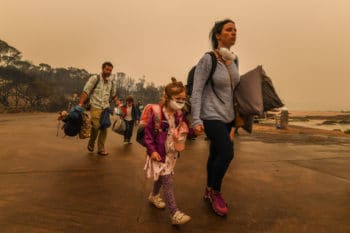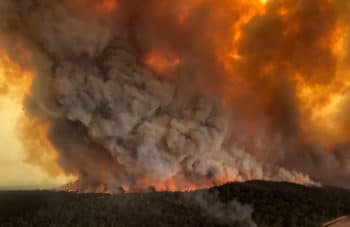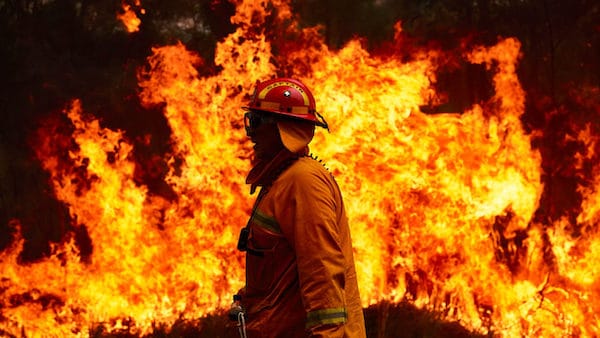Australia is sometimes called “the fire continent” because the ecology of the world’s driest inhabited land has been shaped by repeated burning. But even the fire continent has never seen anything like the recent conflagrations.
Bush fires have been raging in the southeastern states of New South Wales and Victoria for four months now. More than 38,000 square miles, an area the size of South Carolina, have burned. At least 28 people have died and some 2,000 houses in rural towns have been destroyed.
In Mallacoota, a coastal town in Victoria, 1,000 residents and tourists were rescued from the beach by the Australian navy as the flames closed in. Even the vineyards of the Adelaide hills, home of some of the country’s most prized and widely exported chardonnays and sauvignon blancs, have burned. Adding to the mayhem, state authorities in South Australia have been shooting thousands of camels to protect aboriginal communities besieged by herds of the feral animals searching for water.
But seemingly only the country’s climate-denial politicians are surprised. Australia’s meteorologists and fire chiefs had been predicting a record fire season for months. The weather watchers saw early in the year that Australia faced a fire-raising combination of natural rainfall cycles—notably fluctuations in sea temperatures in the Indian Ocean that brought high temperatures and drought to southeast Australia this year—and a very unnatural trend toward a hotter and drier climate. The ensuing blazes have attracted worldwide attention, in large measure because they are part of a pattern of intensifying fires from the Arctic to the Amazon.
Australia is among the countries most exposed to the gathering pace of planet-wide warming. Last year, Australia experienced its highest recorded temperatures, 1.5 degrees Celsius (2.7 degrees Fahrenheit) above the late 20th century average, and 2 degrees C (3.6 degrees F) above the early 20th century average — twice the global increase. The year also saw the six hottest days ever recorded in Australia, maxing out at 49.9 degrees C, or 122 degrees F.
Higher temperatures are ensuring that vegetation dries out faster and further in droughts, creating extreme fire risk. And the droughts have come. Australia’s average rainfall in 2019, at 10.9 inches, was 40 percent below the late 20th century average and 12 percent below the previous lowest. The resulting fires far exceeded in extent Australia’s most deadly bushfire disaster in February 2009, when 173 people died but only 1,700 square miles burned.
As the country has reacted in horror, meteorologists have said, in effect, “We told you so.” The rising fire risk was predicted by the Australian Bureau of Meteorology’s senior research scientist Chris Lucas, who warned 13 years ago that in southeast Australia “fire seasons will start earlier and end slightly later, while being generally more intense. This effect… should be apparent by 2020.”And so it has proved.
In a paper published last September with Sarah Harris of the Country Fire Authority in Victoria, Lucas reiterated that “anthropogenic climate change is the primary driver” of increased fire vulnerability. The analysis did not make a good fit with the posturing of the nation’s politicians, who in recent weeks have had to defend their notorious skepticism about climate change, continued support of fossil fuels, and failure to increase funding for fire services. In a radio interview in November, as the fires gathered pace, Deputy Prime Minister Michael McCormack dismissed any link to climate change as “the ravings of some pure, enlightened, and woke capital-city greenies.”

Residents of Mallacoota in Victoria are evacuated by army personnel on January 3. JUSTIN MCMANUS:THE AGE:FAIRFAX MEDIA VIA GETTY IMAGES
Now, with Australians demonstrating in the streets against his policies, Prime Minister Scott Morrison has been forced to concede the “greenies” were right all along. “We’re living in longer, hotter, drier summers,” he said in a recent TV interview. “This is obviously affected by the broader changes in climate.”
Australia is used to bushfires. Its history is littered with the havoc they can bring: Black Friday in 1939, when 7,700 square miles burned and 71 people died; Black Tuesday in 1967, when 1,020 square miles burned and 62 died; and Black Saturday in 2009. Much of its ecology, including its iconic eucalyptus forests, depends on regular fires,
Australia has more than 800 endemic eucalyptus species, comprising around three-quarters of its forests. Most species thrive in fire-prone areas with nutrient-poor soils. Their foliage is rich in oils that readily burn, releasing their seeds from woody capsules and creating areas of nutrient-rich ash where the seeds will germinate.
But, much as they need fire, too much fire can wipe them out. And this year it has been so hot and dry that the fires have spread into forests with eucalyptus species adapted to wetter conditions, according to David Bowman, a fire ecologist at the University of Tasmania. Whether they can recover will be a critical question for forest ecologists.
Equally uncertain is how wildlife is coping. Chris Dickman of the University of Sydney hazarded a guess—based on his previous assessment of animal densities done for the environmental group WWF Australia—that more than a billion mammals, reptiles, and birds could have perished already, either burned, starved, or eaten by predators such as raptors and feral cats that stalk fire zones.
But Kate Parr of the University of Liverpool, an expert on assessing the impact of wildfires on wildlife, said the estimate was based on sparse field data. Moreover, it assumes no survivors, which may be unduly pessimistic. “Australia’s animals have a long and impressive history of co-existing with fire,” says Dale Nimmo of Charles Sturt University in New South Wales. Some have well-developed escape routines. Others hunker down in deep burrows and may go into temporary hibernation until the fires are gone and food sources start to return.
Singed koalas have featured strongly in TV reports of the fires. They may be individually vulnerable, but most koalas live outside the fire zones, says Ayesha Tulloch of the University of Sydney.
Nonetheless, the exceptional nature of the fires could overwhelm the best coping strategies. “The full effect of the fires… will certainly cause the extinction of some of Australia’s most iconic, fragile, and beautiful inhabitants,” says Ben Garrod, an evolutionary biologist at the University of East Anglia in the UK. Among those at highest risk are endangered species that live mostly in the fire zones, including the eastern bristlebird; the long-footed potoroo, a rabbit-sized marsupial; and the silver-headed antechinus, a mouse-sized carnivorous marsupial only discovered in 2013.
Some foresters have argued that the ferocity of the recent fires is due, in part, to there being too much wood to burn. Rod Keenan of the University of Melbourne, who gets funding from the forestry industry, blames the megafires on the reluctance of the authorities to carry out preemptive controlled burning of dead wood early in the dry season. Forester Vic Jurskis, in a well-publicized open letter to the prime minister, blamed the reluctance on a “green influence on politics.”

A wallaby licks its burnt paws after escaping a bushfire near the township of Nana Glen in New South Wales in November 2019. WOLTER PEETERS:THE SYDNEY MORNING HERALD VIA GETTY IMAGES
But that charge is misplaced. Ecologists have long since realized that it can be necessary to set fires to prevent fires. The United States learned the hard way in 1988, when Yellowstone burned, that preventing all fires is a recipe for storing up fuel for future megafires. And Australian environmental campaigners know it, too. In a policy paper drawn up in 2017, long before the present fires, Australia’s Green Party called for a “scientifically based, ecologically appropriate use of fire” as “an effective and sustainable strategy for fuel-reduction management that will protect biodiversity and moderate the effects of wildfire.”
The story of the Australian bushfires has gained international attention in part because it reflects a global pattern. Fires in the Amazon in August gained as many headlines as the Australian blazes. Similarly, extreme fires in the boreal forests of Siberia burned some 16,000 square miles, according to Greenpeace, with matching conflagrations in Alaska and western Canada. In 2018, California was struck by its deadliest and most extensive wildfires, covering 3,000 square miles and causing more than 100 fatalities. And in 2015, 10,000 square miles of Indonesian forests burned.
Researchers have affirmed that climate change is increasing the risks. A review published this week by British and Australian researchers concluded that “human-induced warming has already led to a global increase in the frequency and severity of fire-weather, increasing the risk of wildfire.” A 2015 global study by Bowman and colleagues looked at trends in the length of droughts. They found that the average “fire-weather season length” had increased by an alarming 19 percent between 1979 and 2013.
Yet despite the rising incidence of drought, the actual extent of fires around the world, though still around 1.3 million square miles every year, has been falling. One study found a 24 percent decline in the past two decades. This was in part due to a decline in deforestation in the Amazon after 2004 (a trend now reversed), and in part because many fewer fires are being set by farmers and pastoralists to clear bush in the increasingly densely populated savanna grasslands of Africa. “When land use intensifies on savannas, fire is used less and less,” says Niels Andela of the NASA Goddard Space Flight Center, who led the research.
More and more of the forest and bush fires that occur globally are due either to the deliberate clearing of forests for permanent agriculture—as in the Amazon and Indonesia—or because a changing climate is dramatically increasing the risk of wildfires. And there is growing evidence that these climate-induced fires are more intense and less amenable to control.
In short, there are fewer fires, but more wildfires.
So is there a way of mitigating the risks? One approach, say many ecologists, is to accept that all fires are not bad and to learn from indigenous methods of using fire to manage the land. In North America, “native people burned extensively,” says Lee Klinger, formerly at the National Center for Atmospheric Research (NCAR) and now an independent scientist who has studied fire regimes in California.
Before Europeans arrived, traditional burning ensured that there were many more fires in forests on the West Coast than today, he says. “But they burned more frequently, and so less destructively,” said Klinger. “There were ground fires, but not the canopy fires we see today.”
Australian researchers and aboriginal communities say much the same. Traditional aboriginal “fire-stick” farming certainly changed the ecology by setting small fires to clear land for cultivation. But many researchers say the effects could be beneficial. This “cool burning” maintained open grasslands, extended the range of fire-adapted species, and often increased local biodiversity by creating mosaics of different habitats. “Aboriginal burning was critical for the maintenance of habitats for small mammals,” according to Bowman, who has coined the term “pyrodiversity” to describe its biodiversity benefits.

Wildfires in Bairnsdale, Australia on December 30. GLEN MOREY : AP
The question now is whether even such intelligent means of fire management can hold back the flames. With climate change leaving the bush bone dry, and with temperatures soaring to levels much higher than local ecosystems are adapted to, the old ways may no longer work.
The question is especially pertinent for Australia. Most climate models predict that “Australia will warm faster than the rest of the world,” says Kevin Hennessy, climate researcher at the CSIRO, Australia’s national research agency. Global heating will also likely cause a continued decline in rainfall in southern Australia, resulting in longer droughts and many more days with severe fire danger.
But Australia’s current fires increasingly look like a harbinger of new conflagrations elsewhere. During a period of strong warming in the American West over the past half century, the number of wildfires covering more than 1.5 square miles has increased fivefold—a trend that the researchers link to higher temperatures and longer droughts, and expect to continue.
In Mediterranean Europe, where wildfires are an increasing summer threat from Portugal to Greece, researchers predict a 40 to 100 percent increase, depending largely on temperature increases. Few doubt that fires will also become more frequent in the boreal forests of the far north as the Arctic warms. Most recently, a paper published last week in Science argued that a lethal combination of deforestation and climate change will double the area burned annually by wildfires in the southern Amazon by 2050. Paulo Brando of the Woods Hole Research Center in Massachusetts titled his paper: “The Gathering Firestorm.”

